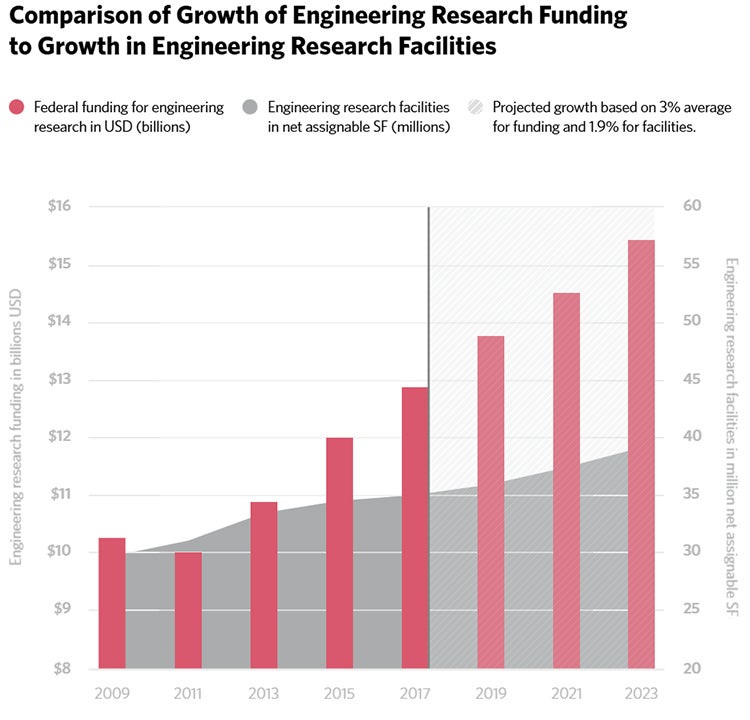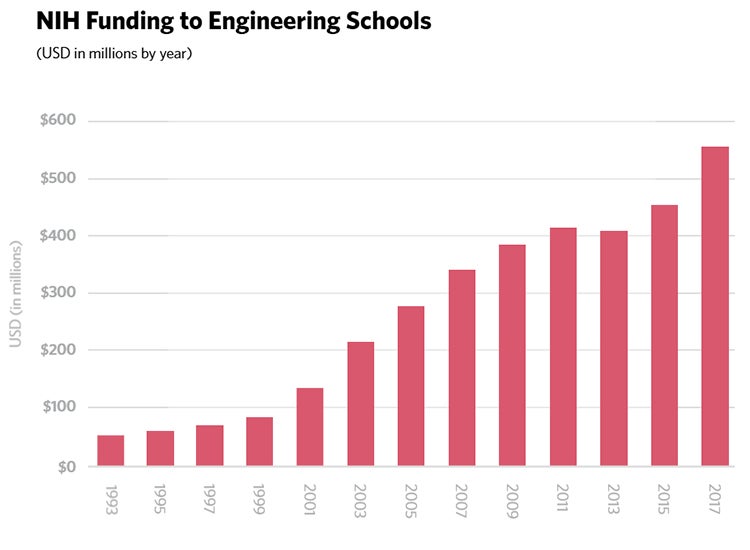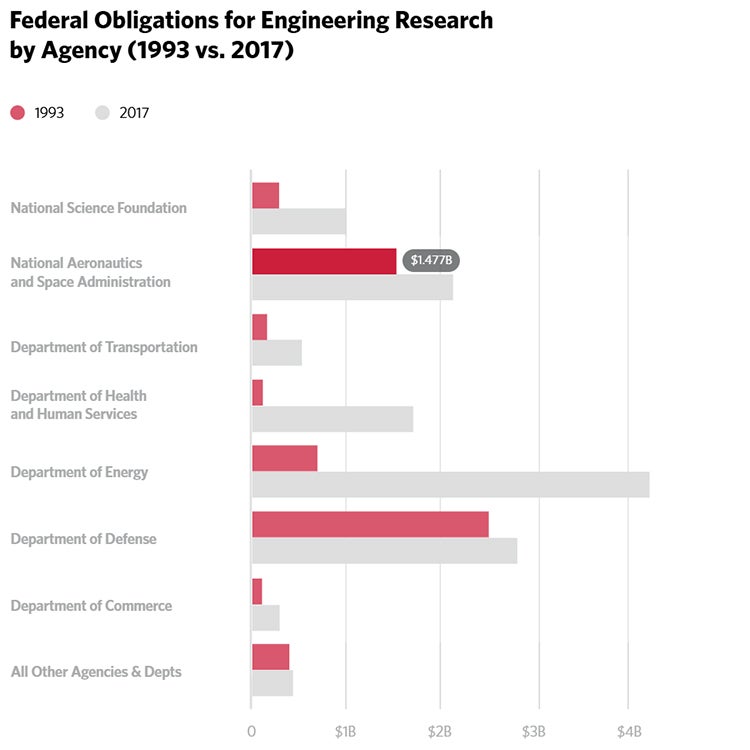
Optimizing Engineering Research Facilities: 5 Strategies to Get Started
Strategic facilities planning and programming studies can help magnify engineering research solutions that more fully leverage expensive equipment and specialized facilities while supporting research productivity and collaboration.
Academic engineering research is at an interesting crossroads. Funding sources are increasing and diversifying due to the ever-expanding range of disciplines benefitting from engineering innovation. Many academic institutions have realized that their current facilities and equipment may not keep up with the growth and demand, but at the same time are hesitant to make major investments without an informed plan that addresses rapidly changing disciplines and intensified societal expectations. The graph below indicates how engineering research funding is growing faster (~3% per year) than space dedicated to engineering research (~1.9% per year).
The facility implications are clear: a need exists for more efficient use of existing facilities and the demand for additional space is growing. In this article, we describe strategies that can help academic institutions make wise investments in their engineering research enterprises.

A Snapshot of Engineering Research Today
An Emphasis on Productivity, Economic and Societal Value
Basic scientific research tends to be at the outer edges of present knowledge, concerned with the discovery of new phenomena and their integration into conceptual models of our universe. Most scientific knowledge will, in a highly variable and unpredictable fashion, find technical applications of economic and social value, but in most cases the nature of such applications will not be apparent to those who perform the original scientific research.
By contrast, engineering research is concentrated on developing, designing, producing, constructing and operating devices, structures, machines and systems with a more immediate focus on economic and societal value. However, not all potential applications can be anticipated, and occasionally the hoped-for application may not be nearly as important as a serendipitous one. The time from discovery to production may be a few years, as in the development and application of the laser or in the progression from the integrated circuit to microprocessor, or it may be decades, as in the development of television.[1]
An Interdisciplinary Approach to Big, Global Challenges
Despite this interesting dichotomy between the intended outcomes underpinning basic scientific research and engineering research – increasingly, we’re discovering there is more crossover between the two due to the rise of interdisciplinary research and its ability to help institutions tackle big, global challenges. The interdisciplinary solutions being developed embed data, prioritize sustainability, and incorporate significant complexity.
Funding models underscore this shift. Traditionally, research conducted in engineering disciplines has been funded primarily by the National Science Foundation, Department of Defense and Department of Energy. Yet, the National Institute of Health’s funding for engineering research has also risen dramatically over the last two decades, indicative of the increased emphasis in cross-disciplinary research with life sciences.


Engineering Research Enterprise Pushed to Capacity
This rise in interdisciplinary research, combined with the emphasis on the economic and societal value inherent to the engineering research enterprise, is challenging the capacity of specialized research facilities at many universities, federally funded research and development centers (FFRDCs) and university affiliated research centers (UARCs). Much like the nanotechnology wave that swept through academic and government establishments and drove demand for cleanrooms and advanced materials characterization several years ago, new research themes are emerging that require more capacity for biomedical labs, life science imaging, molecular engineering, quantum information systems, simulated environments for AI and full scale testing of robotics and autonomous systems. And similar to the nanoscience wave, precision instruments and testing equipment used in these endeavors, along with the facilities that support them, are expensive to obtain and maintain.
Strategic Facilities Planning as an Optimization Tool
This then, is the challenge put before planners and designers working with universities and institutes: How can a facility asset meet today’s multi-disciplinary needs for integrated engineering research while maintaining flexibility to morph with the next generation of grand challenges?
1. Explore the Opportunities (and Challenges) of Shared Advanced Research Facilities
Shared research facilities offer an opportunity for academic institutions to support not only engineering research, but their partners in traditional physical science disciplines, life sciences and even social sciences. For example, advanced imaging systems like cryo-electron microscopes used in the characterization of proteins are used by both biomedical engineers (applied science) and structural biologists (basic science). At the opposite end of the facility spectrum, full scale mock-ups of real world tableaus can accommodate everything from testing of AI facial recognition systems to modeling how a virus spreads in crowds.
While potentially a great utilization of resources, shared research facilities face their own challenges. They are expensive to construct, equip with major research instruments and maintain. They need to be used by a host of subscribers to be financially viable for any institution or they will sit idle and fail through lack of use and funding support. As a result, some universities and FFRDCs are investing in trans-institutional research centers. These theme-based centers are intended to provide platforms for innovation in which engineers and scientists work side by side using shared laboratories and equipment to solve grand challenges that cross multiple fields of study.
Aside from the inherent funding issues in a trans-institutional facility, there are facility design implications as well. These range from “Where should the facility be located and how is space allocated within it?” to “What does building management look like when it isn’t ‘owned’ by one group?” to “How can we assemble the infrastructure we need to test and integrate systems with widely different needs?”
2. Recognize the Value of Facilities Planning Studies to Clarify Research Needs
Strategic facilities planning studies can bring clarity and response to these challenging questions. Engineering research will generally use diverse types of space to fulfill requirements for benchtop study, fabrication, assembly, integration and test functions. These complex and technically challenging research environments need to be informed by an understanding of “what works” and how past solutions can be stripped down to their essentials to provide the backbone and infrastructure needed without designing for the “one-off” capability of a single instrument or test protocol. By evaluating both short-term and long-range programs across the organization and establishing growth projections and program types that need to be supported by core or shared lab capabilities, a strategic study helps determine the unmet lab needs across the organization or on the campus and suggest how future projects can help address them.
3. Conduct Strategic Facilities Planning as Early in the Process as Possible
Five years ago, HDR conducted a research facility planning and programming study for SLAC National Laboratory, which is affiliated with Stanford University, to help determine how their new photon science laboratory building could be positioned to support their widely diverse research initiatives. We completed the strategic lab programming and planning report over roughly six weeks. It was then used to develop bridging documents for the core and shell of the new building; be incorporated into a conceptual design report (also completed by HDR); and ultimately inform the photon science lab fit-out at the new Arrillaga Science Center. Among the benefits of the early strategic lab plan were:
- Completed prior to selection of a building site
- Informed the building program without identifying specific lab users
- Provided flexibility for the laboratory to investigate different space assignments and functions until the building fitout design stage
- Provided for flexibility of use as both engineering research and basic science space
4. Integrate Flexibility and Adaptability into the Plan
For the same SLAC project, our team identified areas on campus that were not yet fully occupied and could accommodate growth and spaces that could be easily converted to additional wet lab, dry lab and office space. We also interviewed laboratory leadership and key user teams to identify the directions of long-term research in basic sciences and engineering applications. These two sets of data determined the laboratory types that were most needed, which proved to be wet laboratory capabilities for collaborative biological, chemical and materials research, and specialty facilities for next generation precision instruments.
We then developed a planning unit or “module” that could be used to integrate flexibility and adaptability into the design of any new building. The lab footprint can accommodate wet laboratory, dry laboratory, cleanroom and precision controlled environment space across all zones of the building. The building mechanical and electrical systems are then designed to support specific lab environments within each region or zone, providing flexibility within each zone without the need to over-build all of the zones of the building. Our team also provided example layouts and ideal adjacencies for synthesis and catalysis labs; laser, optics, photonics labs; cleanrooms; and precision environments. These layouts demonstrated that analytical instruments, such as XRD, XPS, mass spectrometry, UV/Vis spectrometers, or FTIR spectrometers could very easily fit and be supported by dry lab space within the flexible planning module; however, high resolution instruments such as the CryoTEM and Environmental TEM (ETEM) would require very specialized environments in order for the precision instruments to perform as intended. Ultimately, HDR recommended a fully flexible One-third Dry Lab / Two-thirds Wet Lab solution for the primary laboratory program for the photon science lab building, with an additional zone for specialized low vibration – precision controlled labs.
5. Develop Evaluation Criteria to Set Priorities
Our HDR team has also developed a strategic facilities plan, including a specific facility vetting process, for the Johns Hopkins University Applied Physics Laboratory (APL), a UARC in Laurel, MD. APL provides solutions to national security and scientific challenges through systems engineering and integration, research and development, and analysis. Prior to initiating the study, proposals for program facilities needs were submitted by APL’s mission areas (operational directorates) for consideration. The HDR strategic planning team worked closely with APL to establish a set of criteria that would be used to determine the priorities for incorporating these proposals into the next systems integration building for engineering research.
These evaluation criteria included the status of existing facilities, such as the condition of the current space and its fitness for the research purpose, location and adjacency, and other demands for that space from within APL. Also included were criteria regarding adjacency to other proposed systems integration building users and compatibility of uses. Parallel criteria were established for proposed new facilities including if they were providing new capability or duplicating existing, compatibility with other occupants, the time horizon to bring the new capabilities on-line and programmatic funding.
Each criteria was then scored first by the strategic planning team to provide third party objectivity, and then reviewed by the APL steering committee. This process was intended to be iterative, allowing for additional feedback or investigation of options and allowing sufficient discussion to give the steering committee confidence to endorse the proposed initial program for the near term systems integration building and to establish priorities for future projects.
Ultimately this strategic selection process, based on data analysis and broader consensus, led to the building program. It also outlined future facility needs to be met by new building and renovation of the backfilled areas so that each asset could be designed to be robust, flexible, and optimized to its best purpose.
Assessing Existing Facilities
Facilities assessments can help institutions assess their building stock based on its ability to support research programs. Priorities will vary in each institution, but there are some general considerations that will apply in most situations.
These considerations can systematically be built into an assessment matrix, and weighted appropriately, to assist in making decisions regarding new facilities, program needs, and resource allocation across campus.
Compliance
- Can research activities be safely supported?
- Are existing facilities technically reliable enough to assure test results are accurate and repeatable?
- Are research/engineering activities hindered in any way by the existing facilities?
- Do the activities and equipment in the facility interfere with being a "good neighbor“ to other facilities in the building?
Some considerations include:
- Vibration sources and sensitive measurements
- RF sources and sensitive electronics
- Lab cleanliness requirements
- High bay vehicle space and access
Lab Space Optimization
- Is the existing lab space utilized to maximize value to the campus?
- Could another function occupy the existing lab space more effectively?
- Does the existing program under-utilize the capabilities of the space (i.e. a computing lab in a high bay)
- Does the current location optimize adjacencies to other programs?
Risk
Technical Risk
- Will moving research functions cause a loss of critical features of the facility?
- Will the pick-up and put-down of the facility cause harm to the instruments, test results, or the program?
Operational Risk
- How will downtime associated with relocating impact the research functions and sponsored projects?
- How will downtime affect graduate student timetables (if applicable)?
Financial Risk
- What are the cost impacts of relocating?
- Can operating costs be significantly reduced by relocating?
Shared Capabilities
- Does the research program utilize any functions (e.g., anechoic test chamber, or antenna platform) or support capability (i.e. machine shop) that are shared across programs?
- If not, would relocation allow the research program to take advantage of shared functions and capabilities?
Cost
- What are the costs associated with moving or replacing research functions to a different location?
- For example, does the current program include “high cost” spaces (e.g., cleanrooms and anechoic chambers) that would be expensive to move and/or replace?
- Is it more cost effective to upgrade in place than to build new?
- Will capital costs of new facilities outweigh on-going operating costs (deferred maintenance, energy use)?
Co-location Synergy
- Does the current facility support synergy through personnel interactions, and opportunities to share staff resources across projects with similar facility needs?
- If not, could this synergy be better supported elsewhere?
- Would co-location with other programs under consideration result in more and richer collaborations?
A Home for Future-Oriented Research Activities
A 2017 US National Academy of Engineering report reviewing international models for center-based, multidisciplinary engineering research reached the conclusion that future university-industry research centers should (1) prioritize industry needs in determining the challenges they address, (2) be agile and adaptable to translating, scaling-up, and industrializing the solutions generated, and (3) be networked and aligned in order to fully leverage complementary capabilities and resources of other national, regional, and international innovation actors. The types of wide-ranging approaches and thoughtful facilities planning strategies outlined in the case studies above are needed to assure that the facilities used by engineering research centers are equipped to meet these goals.
[1] "What Is Engineering Research and How Do Engineering and Science Interact?." National Academy of Engineering. 1995. Forces Shaping the U.S. Academic Engineering Research Enterprise. Washington, DC: The National Academies Press. doi: 10.17226/4933




